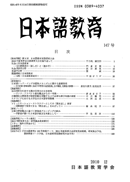Volume 170
Displaying 1-10 of 10 articles from this issue
- |<
- <
- 1
- >
- >|
FEATURED ARTICLE
-
2018Volume 170 Pages 1-16
Published: 2018
Released on J-STAGE: August 26, 2020
Download PDF (2470K)
REGULAR ISSUE
Research Paper
-
2018Volume 170 Pages 17-31
Published: 2018
Released on J-STAGE: August 26, 2020
Download PDF (2270K) -
2018Volume 170 Pages 32-46
Published: 2018
Released on J-STAGE: August 26, 2020
Download PDF (2373K) -
2018Volume 170 Pages 47-61
Published: 2018
Released on J-STAGE: August 26, 2020
Download PDF (2263K) -
2018Volume 170 Pages 62-77
Published: 2018
Released on J-STAGE: August 26, 2020
Download PDF (2777K)
Survey Article
-
2018Volume 170 Pages 78-91
Published: 2018
Released on J-STAGE: August 26, 2020
Download PDF (2373K) -
2018Volume 170 Pages 92-106
Published: 2018
Released on J-STAGE: August 26, 2020
Download PDF (2408K) -
2018Volume 170 Pages 107-121
Published: 2018
Released on J-STAGE: August 26, 2020
Download PDF (2323K)
Research Note
-
2018Volume 170 Pages 122-129
Published: 2018
Released on J-STAGE: August 26, 2020
Download PDF (2093K) -
2018Volume 170 Pages 130-137
Published: 2018
Released on J-STAGE: August 26, 2020
Download PDF (2036K)
- |<
- <
- 1
- >
- >|
